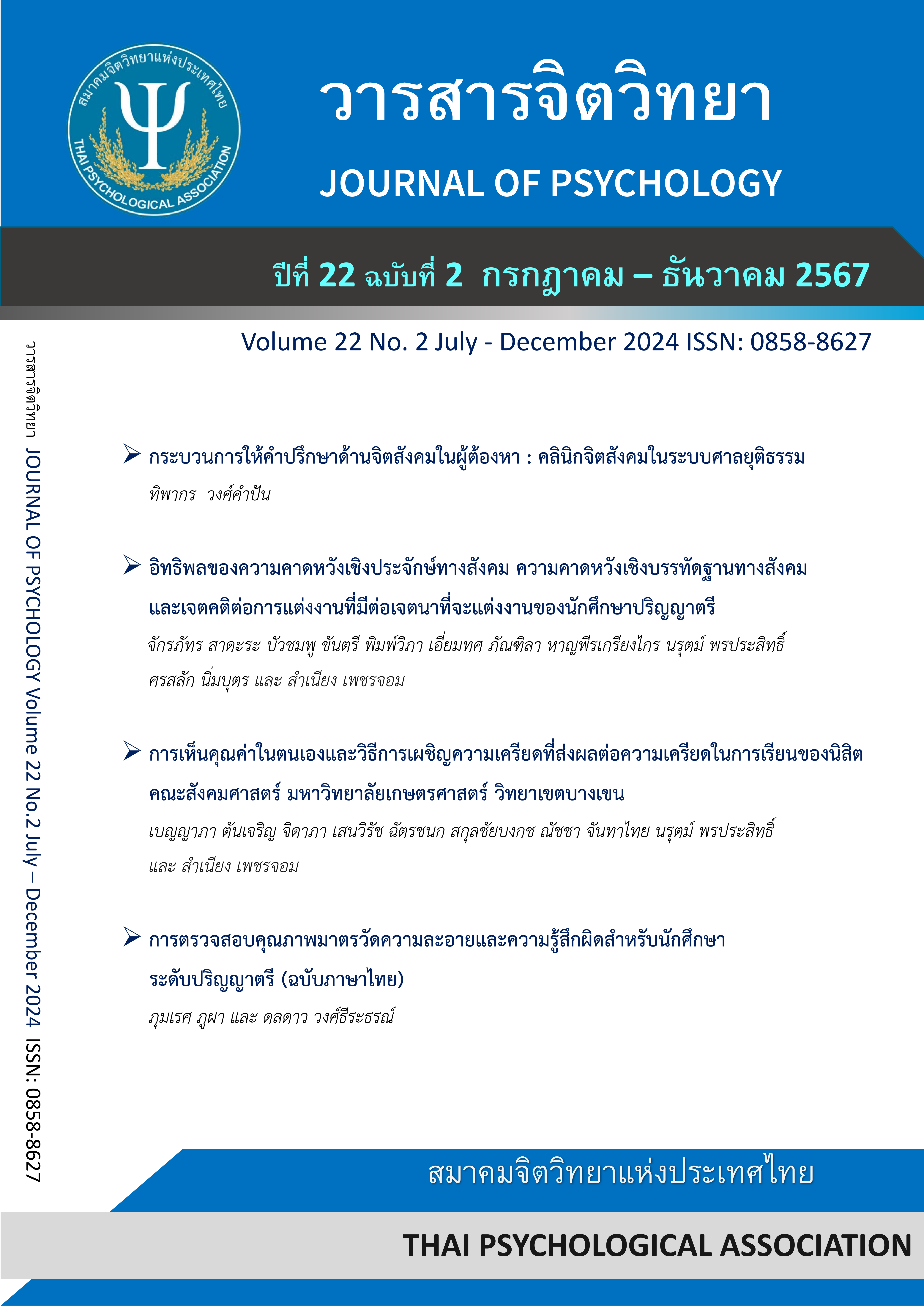อิทธิพลของความคาดหวังเชิงประจักษ์ทางสังคม ความคาดหวังเชิงบรรทัดฐานทางสังคมและ เจตคติต่อการแต่งงานที่มีต่อเจตนาที่จะแต่งงานของนักศึกษาปริญญาตรี
Main Article Content
บทคัดย่อ
บทคัดย่อ
การแต่งงานถือเป็นหนึ่งในเหตุการณ์สำคัญของชีวิตที่ได้รับความสนใจในด้านสังคมและวัฒนธรรมทั่วโลก การวิจัยครั้งนี้มีวัตถุประสงค์เพื่อศึกษาอิทธิพลของความคาดหวังเชิงประจักษ์ทางสังคม ความคาดหวังเชิงบรรทัดฐานทางสังคม และเจตคติต่อการแต่งงานที่มีต่อเจตนาที่จะแต่งงานของนักศึกษาระดับปริญญาตรี กลุ่มตัวอย่างที่ใช้ศึกษาครั้งนี้เป็นนักศึกษาระดับปริญญาตรีที่กำลังศึกษาในมหาวิทยาลัยที่ตั้งอยู่ในประเทศไทย จำนวน 216 คน ด้วยวิธีการสุ่มโดยบังเอิญ เครื่องมือที่ใช้ในการวิจัย ประกอบด้วย การเก็บรวบรวมโดยใช้แบบสอบถาม จำนวน 5 ตอน ได้แก่ แบบสอบถามปัจจัยส่วนบุคคล แบบสอบถามเจตคติต่อการแต่งงาน แบบสอบถามความคาดหวังเชิงประจักษ์ทางสังคม แบบสอบถามความคาดหวังเชิงบรรทัดฐานทางสังคม และแบบสอบถามเจตนาที่จะแต่งงาน โดยค่าสัมประสิทธิ์แอลฟาครอนบาคของแบบสอบถาม มีค่าระหว่าง 0.81 -0.88 วิเคราะห์ข้อมูลโดยใช้โปรแกรมสำเร็จรูปทางสถิติ สถิติที่ใช้คือ ค่าร้อยละ ค่าเฉลี่ย ค่าส่วนเบี่ยงเบนมาตรฐาน ค่าสัมประสัมประสิทธิ์สหสัมพันธ์ของเพียร์สัน และการวิเคราะห์การถดถอย ผลการวิจัยพบว่าอิทธิพลของเจตคติต่อการแต่งงาน (β = 0.872 , p < .001) สามารถมีอำนาจในการทำนายเจตนา ที่จะแต่งงานของนักศึกษาปริญญาตรีได้อย่างมีนัยสำคัญทางสถิติที่ .001 ในขณะที่ความคาดหวังเชิงประจักษ์ทางสังคมและความคาดหวังเชิงบรรทัดฐานทางสังคมไม่ได้แสดงนัยสำคัญทางสถิติแต่อย่างใด ผลการวิจัยนี้สามารถนำไปใช้เป็นข้อมูลพื้นฐานในการพัฒนานโยบายหรือแนวทางการส่งเสริมความเข้าใจเกี่ยวกับการแต่งงานในกลุ่มนักศึกษาระดับปริญญาตรีโดยมุ่งเน้นไปที่การสร้างเจตคติที่ดีต่อการแต่งงาน
Article Details

This work is licensed under a Creative Commons Attribution-NonCommercial-NoDerivatives 4.0 International License.
บทความที่ได้รับการตีพิมพ์เป็นลิขสิทธิ์ของสมาคมจิตวิทยาแห่งประเทศไทย
ข้อความที่ปรากฎในบทความแต่ละเรื่องในวารสารวิชาการเล่มนี้เป็นความคิดเห็นส่วนตัวของผู้เขียนแต่ละท่านไม่เกี่ยวข้องกับสมาคมจิตวิทยาแห่งประเทศไทย แต่อย่างใด ความรับผิดชอบองค์ประกอบทั้งหมดของบทความแต่ละเรื่องเป็นของผู้เขียนแต่ละท่าน หากมีความผิดพลาดใด ๆ ผู้เขียนแต่ละท่านจะรับผิดชอบบทความของตนเองแต่ผู้เดียว
References
เอกสารอ้างอิง
สำนักงานปลัดกระทรวงการอุดมศึกษา วิทยาศาสตร์ วิจัยและนวัตกรรม. (2567). สรุป รายงานจำนวน
นักศึกษา ปีการศึกษา 2567 ภาคการศึกษาที่ 1.
https://info.mhesi.go.th/stat_std_all.php?search_year=2567
บุญใจ ศรีสถิตย์นรากูร. (2563). ขนาดอิทธิพล การวิเคราะห์อำนาจ การคำนวณขนาดตัวอย่างที่เหมาะสมโดย
โปรแกรม G*Power. สำนักพิมพ์จุฬาลงกรณ์มหาวิทยาลัย.
อมินดารา อริยธาดา. (2564). รูปแบบความสัมพันธ์เชิงสาเหตุด้านคุณลักษณะทางจิตและสภาพแวดล้อม
ทางการศึกษา ที่ส่งผลต่อพฤติกรรมการมุ่งเน้นการเป็นผู้ประกอบการ โดยส่งผ่านความตั้งใจที่จะเป็นผู้ประกอบการของนักศึกษา สาขาผู้ประกอบการ (ปริญญา
นิพนธ์วิทยาศาสตร์มหาบัณฑิต, มหาวิทยาลัยศรีนครินทรวิโรฒ).
Abdurahman, D., Assefa, N., & Berhane, Y. (2023). Adolescent Girl’s Early Intention to
marriage and its Determinants in Eastern Ethiopia: A Social Norms Perspective. Sage Open, 13(2), 1-11.
https://doi.org/10.1177/21582440231182352
Ajzen, I. (1991). The theory of planned behavior. Organizational Behavior and Human
Decision Processes, 50(2), 179–211. https://doi.org/10.1016/0749-5978(91)90020-T
Fishbein, M., & Ajzen, I. (1975). Belief, Attitude, Intention, and Behavior: An Introduction to Theory and Research. Reading, MA: Addison-WesleyAjzen, I. (2020). The theory of planned behavior: Frequently
asked questions. Human Behavior and Emerging Technolo-gies,2(4), 314–324
Ajzen, I. (2020). The theory of planned behavior: Frequently asked questions. Human Behavior and Emerging Technolo-gies,2(4), 314–
https://doi.org/10.1002/hbe2.195
GBD 2021 Fertility and Forecasting Collaborators. (2024). Global fertility in 204
countries and territories, 1950–2021, with forecasts to 2100: A comprehensive demographic analysis for the Global Burden of
Disease Study 2021. The Lancet (London, England), 403(10440), 2057–2099. https://doi.org/10.1016/S0140-6736(24)00550-6
Bicchieri, C. (2006) The grammar of society: The nature and dynamics of social norms.
CamBibridge University Press, New York.
Bicchieri, C., & Mercier, H. (2014). Norms and beliefs: How change occurs. In M. Xenitidou & B.
Edmonds (Eds.), The complexity of social norms (pp. 37–54). https://doi.org/10.1007/978-3-319-05308-0_3
Fishbein, M., & Ajzen, I. (1975). Belief, Attitude, Intention, and Behavior: An Introduction to
Theory and Research. Reading, MA: Addison-Wesley
Fukuda, S. (2020). Marriage will (continue to) be the key to the future of fertility in Japan and
East Asia. Vienna Yearbook of Population Research, 18, 71–80. DOI: 10.1553/populationyearbook2020.deb07
Jaisuekun, K., & Sunanta, S. (2023). Til death do us part? End-of-life care for ageing Western
husbands in Thailand. Gender, Place & Culture, 31(12), 1667-1689.
https://doi.org/10.1080/0966369X.2023.2229059
Lee, M. (2022). The Consequences of Declining Fertility for Social Capital: Joint Economic
Committee Report. Joint Economic Committee Replubicans. https://www.jec.senate.gov/public/_cache/files/635c69dc-6a5a-467b-
b7b0-3ab906fb4a94/the-consequences-of-declining-fertility-for-social-capital.pdf
Mackie, G., Moneti, F., Denny, E., & Shakya, H. (2015). What are social norms? How are they
measured? San Diego, CA: UNICEF and University of California, San Diego, Center on Global Justice.
Nejatian, M., Alami, A., Tehrani, H., Jahantigh, H., & Jafari, A. (2021). Attitude, Intent and
Different Aspects of Marriage in University Students: A Path Analysis. Journal of Divorce & Remarriage, 63(3), 184–199.
https://doi.org/10.1080/10502556.2021.1993024
Panpothong, N., & Phakdeephasook, S. (2023). Independence or Interdependence?: The Thai
Self-Construal as Reflected by Linguistic Evidence. Manusya: Journal of Humanities, 26(1), 1-25. https://doi.org/10.1163/26659077-
Pummanee, T., Tedla, Y. G., & Riesch, S. K. (2018). Barriers to the quality of parent-adolescent
communication in Thailand: An ecological system analysis. International Journal of Child Development and Mental Health, 6(1), 87-
Retrieved from https://he01.tci-thaijo.org/index.php/cdmh/article/view/122867
Rattanawijan, S. ., & Srimuang, D. (2022). “Why Do Not You Get Married?”: World View of
Woman and Marriage in Thai Society. Academic and Research Journal of Liberal Arts (Online), 17(2), 190–204.
https://doi.org/10.14456/lar.2022.21
Raymo, J. M., Uchikoshi, F., & Yoda, S. (2021). Marriage intentions, desires, and pathways to
later and less marriage in Japan. Demographic research, 44, 67–98. https://doi.org/10.4054/demres.2021.44.3
Retherford, R. D., Ogawa, N., & Matsukura, R. (2001). Late Marriage and Less Marriage in
Japan. Population and Development Review, 27(1), 65–102. https://doi.org/10.1111/j.1728-4457.2001.00065.x
Shahrabadi, R., KarimShai-Shahanjarini, A., Dashti, S., Soltanian, A., & Garmaroudi, G. (2017).
Predictors of intention to marriage based on theory of planned behavior among university students in Iran. Electronic physician,
(4), 4090–4095. https://doi.org/10.19082/4090
Tamizarasi, K., & Jecinth, J. R. B. (2023). Relationship between general attitude towards
marriage and aspects of marriage in young adults. The International Journal of Indian Psychology, 11(3), 276–283.
https://doi.org/10.25215/1103.276
United Nations Population Fund (UNFPA). (2015). The state of Thailand’s population 2015:
Features of Thai families in the era of low fertility and longevity. Retrieved from https://thailand.unfpa.org
Xie, J., & Hong, X. (2022). Research on Factors Affecting Chinese College Students' marriage
intention: Applying the Theory of Planned Behaviour. Frontiers in psychology, 13, 868275.

